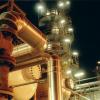Hi
I can't figure out how to convert reaction rate for methane - steam reforming. In various articles it is given as kmol*Pa/s*kg_cat. For reaction rate calculation partial pressure of components are used. I want to change it to molar concentration. For components it's easy, I'm just dividing by RT. But what about reaction rate constant ? Should I use temperature of the process or temperature of the relevance state ? (298 K)

 FB
FB










